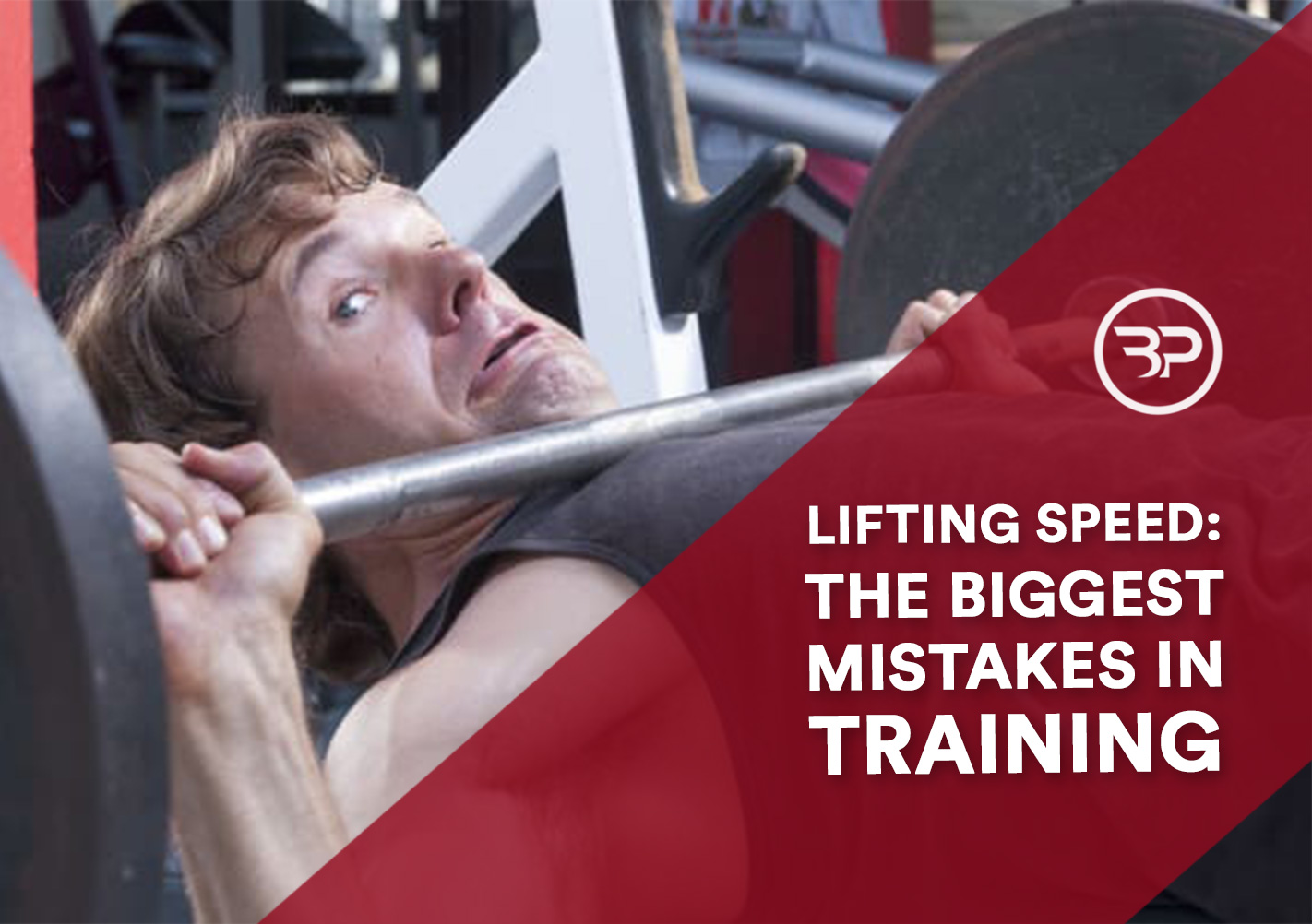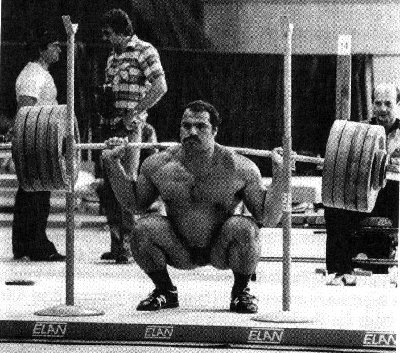Lifting Speed:The Biggest Mistakes In Training
November 5, 2015
By Eric Bach- Get more emails like these sent to your email here.
Key Points:
- Eccentric strength is necessary to maintain position during lifts. It controls deceleration and helps you build muscle mass
- But lifting ONLY fast leaves gaps in muscular and strength development
- You don’t need to be a tempo-counting dweeb
If you’ve been reading this blog for a while, you know I’m a huge proponent of lifting fast. After all, lifting fast (or with maximum intent) helps you recruit more motor units.
That translates into recruiting more muscle. You’ll get jacked and athletic.
But there’s one huge thing most lifters forget: Your strength is only as potent as the foundation of eccentric control it’s built upon.
What the Hell Does That Mean?
The eccentric refers to the lengthening of a muscle. Also termed yielding action, the eccentric portion of a lift opposes the overcoming, or concentric, portion of a lift.
That means the “way down” on a squat, or lowering a barbell to your chest during a bench press. To lift safely, you need to control the resistance during the eccentric and be able to hold position.
This means preventing your knees from diving in, or your back rounding in a squat. Simply put, to train safely and maximize your gains in strength and size, you must have a huge base of eccentric strength and control.
Taken a step further, you don’t even need to “always” lift explosively, and occasionally need to lift with slower tempos and control.
All of which raises a bunch of questions.
Should you drop deadlifts?
Should you turn into a tempo-counting dweeb?
Should you go slow to maximize the “burn” in muscles?
Will slow eccentrics hinder your recovery?
Calm down, dude.
Wait, What? I thought all I needed to do was lift explosively.
There’s nothing wrong with lifting explosively when you’re strong and have great technique.
Problem is, most lifters miss the boat due to a lack of eccentric control and a propensity to only lift fast, regardless of goal. This compromises technique, leading to injuries and major technique issues that prevent you from getting stronger.
Further, without emphasizing the eccentric portion of lifts along with the explosive concentric, gains in strength and size are also minimized. I don’t know about you, but staying smaller, weaker, and jacking up technique is the last thing I want in training.
Regardless of whether you want to get jacked, stronger, or more athletic, the eccentric muscle actions and control are important. You’re only as strong as your weakest link.
In other words, you’re doing yourself a disservice by only training one way.
Leave clunky deadlifts, herky-jerky swing curls, and bottomed out squats by the wayside. It’s time to reinforce movement with controlled eccentrics for rock solid technique, rapid muscle growth, and improved strength.
Why Controlling Your Eccentrics is Super Important
Controlling the eccentric portion of lifts with technical precision is superior than pure explosive concentric training.
1.Improved Technical Practice
Common sense tells us if you can’t control the weight during the eccentric with sub-maximal weight your form will surely breakdown under near-maximal loads.
Controlling the eccentric helps you reinforce body position and technique on your lifts. That means going slower on the negative to maintain joint alignment, such as keeping your back from flexing forward and rounding, and knees from diving into valgus on the squat.
This is the devil in the details. By putting your body in the correct positions you’ll maximize your training without reinforcing bad technique.
What to Do: Train to a biomechanically appropriate depth, ingrain it with a controlled eccentric, and complete the lift. That means the minute your form breaks down, you end your depth or end the rep.
P.S. Get your free eBook 25 Expert Tips to Master Muscle Growth here. Offer expires 10/31/16.
2. More Muscle Growth
Research shows that eccentric training causes increased micro-trauma of the muscle fibers, which in turn can lead to increased muscle growth. In the presence of sound nutrition, controlled eccentrics cause greater muscular damage and subsequent migration of nutrients for recovery and growth to get you jacked.
There’s a fine balance between acceptable and excessive soreness that limits training intensity, frequency, and athletic performance. In the case of competitive explosive athletes, care must be taken to avoid excessive eccentric training if it hinders training frequency and intensity.
For the muscle-building dude like yourself, analyze the trade-off between soreness and training frequency.
Muscle soreness is beneficial for hypertrophy, but only if it doesn’t exceed recovery capabilities and hinder your ability to hit the gym again.
What to Do: Control the eccentric with isolation and hypertrophy focused work. Keep in mind the risk-reward if fatigue and soreness limits training frequency, training intensity, or counteracts the muscular demands of sport.
3.Get Stronger In Stick Points
Many lifters’ greatest weakness is the transition from eccentric to concentric. That includes coming out of the hole on a squat.
Luckily, you’re stronger in the eccentric or yielding portion of a lift. Pausing at weak points helps build strength and stability in the weakest portions of your movements.
Picture the lifter who squats slow until halfway through their descent, then speeds up to the bottom and posteriorly tilts pelvis (buttwink), before the hips shoot up and the lift finishes with a good morning. It might look something like this.
Now, I feel bad for this kid and don’t mean to be a bag of dicks. Beyond the loading being far too heavy, he actually has pretty good eccentric control.
Then, Armageddon. Everything goes to hell on the concentric. In this case, pausing at stick points just out of the hole near 90 degrees would help reinforce stability and control at what looks like his weakest point of the lift. In time, this improves technique to reduce injuries and eliminates sticking points to boost strength.
What to Do: Work on sub-maximal pauses during the stick-points of your lifts. 3-4 sets of 3 reps with 2-3 second pauses will be plenty.
4. Get in the Zone
Slowing down and focusing on your eccentrics gets you maximally mentally engaged on your lifts.
The process of training is maximized through maximizing rep quality first, and quantitative outcomes like weight or volume second.
Nothing requires more focus than pausing under a squat, or holding position near your sticking point. The position of joints dictates which muscles are working; if you’re losing position you’re engraining poor technique and decreasing performance.
” Joint Position Dictates Muscle Function.” Greg Roskopf
What To Do: Sprinkle in 2 sets of 3-5 reps with controlled eccentrics finished with explosive concentric’s in warm-up sets.
5. Improved Sport and Movement Performance
We’ve all seen athletes who can stop on a dime and changes direction, ala Barry Sanders. And we also seen fast athletes who can’t put the brakes on fast enough. They either miss a play or get injured.
Training only concentric based explosive movements limits the development of eccentric strength—a vital form of strength for relative strength and movement deceleration.
Sprinting, change-of-direction work, and the chaotic nature of sports involve huge ground reaction forces that need eccentric strength for control.
Without adequate strength to provide eccentric control, unconditioned bodies wilt under pressure. Trying anything athletic risks injury.
What to Do: If you’re an athlete, train strength through stable range of motion, as mentioned in the squat example above. And control eccentrics on non-ballistic weight-training exercises until control to ingrain control.
The Eccentric Exceptions
Nothing in training is absolute. There’s a time and a place for everything, except for dudes lifting in compression shorts.
Stability, control, strength, and technique are indispensable before most ballistic weight-room exercises are trainable and transferable. That means before you can be explosive, you must be strong and stable.
The Use of Eccentrics Depends on your Goal
Your training style should be dictated based on your goals, and that means varying needs for explosive movement, pure strength work, and hypertrophy work. That’s why power lifters, sprinters, bodybuilders all have different demands that must be trained individually as they advance.
Program your exercises based on neural demands, with explosive exercises followed by heavy strength work and finished with higher volume. Use, longer eccentric exercises if you’re looking for the best of all worlds. The amount of each will be determined by your goals.
Olympic Lifts: Opt for a Controlled Drop
Olympic lifts are ballistic in nature and require subtle concentric muscle actions to rapidly generate force. According to the work of Vladimir Zatsiorsky in The Science and Practice of Strength Training, the usage of eccentric training is limited in transfer for activities that are primarily concentric (Zatsiorsky, 1995).
On a macro-scale, the Olympic lifts require tons of practice and technique from a high frequency of training.
Soreness and fatigue from eccentrics aren’t conducive to optimal training. And it’s unnatural to try to try to control a clean from your shoulders back to the ground. (That’s why we use bumper plates.)
Attempting to reverse the movement of an Olympic lift opens the door for unnecessary injury. Opt for a controlled drop instead.
Stop Dropping All Your Deadlifts
Eccentric strength is important in strengthening the body to hold positions and not all deadlifts should be dropped. That said, there’s a fine line of risk/reward with near-maximal weights and the amount of stress heavy lifts and the ensuing eccentric place on the CNS.If you’re near competition or at the end of a heavy training cycle heavy eccentrics may fry your CNS and zap the strength you’ve been ramping your training for.
But non-competitors should ensure a base of eccentric control on deadlifts. If you can’t control the weight eccentrically when you’re stronger, your form is likely garbage on the concentric.
The Eccentric Trade Off
There is a huge trade off between stress caused from eccentric loading, training volume, and the impact on training frequency and intensity.
If you’re performing timed eccentrics with massive weights, and a high training volume stop in your tracks, you’re setting yourself up for fatigue and stagnation rather than strength, performance, and muscular gains.
On the flip side, if your technique is shaky and muscle growth is stagnant, then a focus on eccentric control in your warm-ups and submaximal sets will reinforce technique and provide additional time under tension to boost muscle growth.
P.S. Get your free eBook 25 Expert Tips to Master Muscle Growth here. Offer expires 10/31/16.
Lifting Speed Recommendations
- Control eccentrics on isolation exercises. They’re meant to isolate, create muscular tension, and damage for growth to get you gainz bro’.
- Train explosively on the concentric action of most movements for explosiveness and maximal muscle fiber recruitment.
- Keep an eye on total training volume. If it’s high, you’re probably already getting a significant eccentric loading volume that must be factored into programming.
- Control eccentrics on machine and cable exercises. Cables and machines apply constant tension through that range of motion in the first place. Use them how they’re supposed to be used.
- Control, technique, and a strength foundation must be in place before rapid eccentrics and ballistic exercises.
- Yes, it’s fine to drop your Olympic lifts, heavy deadlifts, but be reasonable, Bubba and use control.
The Bottom Line
Program your exercises based on neural demands. Use explosive exercises followed by heavy strength work and finished with higher volume, longer eccentric exercises for the best of all worlds.
The best approach to the eccentric depends on your goals.
But all training qualities are improved once you have a foundation of eccentric control.
Only then will you maximize your maximum strength, performance, and muscle-building capabilities.
Zatsiorsky, Vladimir M. “Strength Exercises.” In Science and Practice of Strength Training, 157-158. Champaign, IL: Human Kinetics, 1995.











[…] Lifting Speed: The Biggest Mistakes in Training — Eric Bach […]
[…] Lifting Speed: The Biggest Mistakes In Training – Eric Bach […]
[…] Lifting Speed: The biggest mistakes in training via Eric Bach […]
[…] Lifting Speed:The Biggest Mistakes In Training via Eric Bach […]
[…] Lifting Speed: The Biggest Mistakes in Training – Bach Performance […]
Don’t forget about the ladies who lift bro!
Great article, you made it into the article recommendation of last week
http://christianbosse.com/article-recommendations-week-38-2016/
Keep up the great work!
This is a really good tip particularly to those fresh to the blogosphere.
Short but very precise information… Many thanks for sharing this one.
A must read post!
Rattling informative and good body structure of
content material, now that’s user pleasant (:.
[…] People often equate lifting with a tempo to lifting slowly. […]